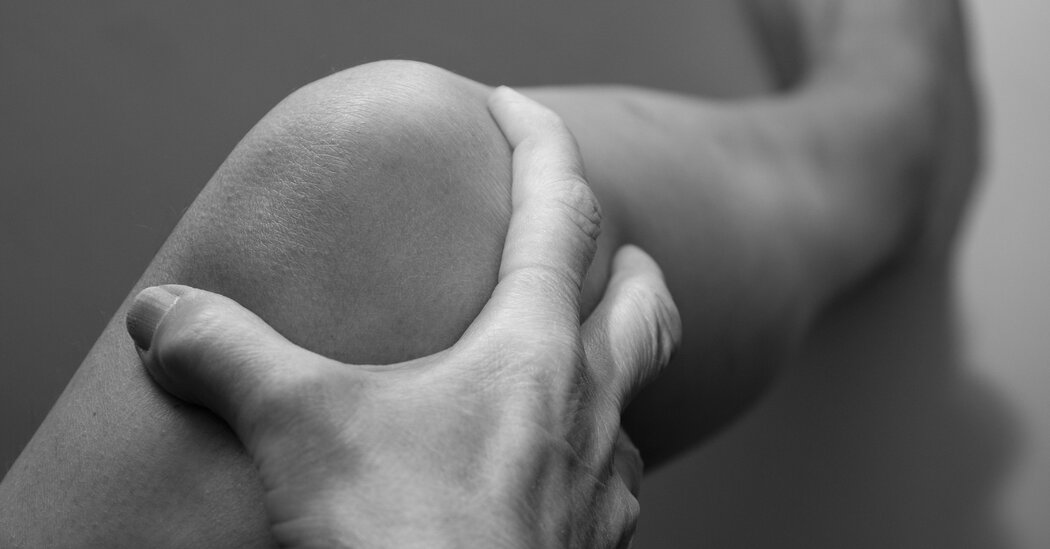
In the annals of unsolicited advice, few nuggets have been dispensed as widely and with less supporting evidence than this: “If you keep doing all that running, you’re going to ruin your knees.”
The latest salvo in the debate over knees and running — a systematic review of 43 previous MRI studies that finds no evidence that running causes either short-term or long-term damage to knee cartilage — is unlikely to convince the opinionated ex-football star at your Thanksgiving table who swears his bum knee was caused by wind sprints. But given that nearly half of Americans are expected to develop painful knee osteoarthritis at some point during their lives, the findings do raise a nagging question: If abstaining from running won’t magically protect your knees, what will?
Feed the cartilage.
Researchers have lately begun to rethink long-held dogmas about the properties of cartilage, the smooth layer of tissue that cushions the bones of the knee and other joints and whose breakdown is the primary cause of osteoarthritis. “Since cartilage doesn’t have a blood or nerve supply, we used to think it couldn’t adapt or repair itself,” said Michaela Khan, a doctoral researcher at the University of British Columbia and the lead author of the new review on running and cartilage, which was published in the journal Sports Medicine.
But that’s not the case. Cyclic weight-bearing activities like walking and — wait for it — running squeeze the cartilage in the knee joint like a sponge, expelling waste and then drawing in a fresh supply of nutrient- and oxygen-rich fluid with each step. Instead of an inert shock-absorber doomed to get brittle and eventually fail with age, Ms. Khan said, cartilage is a living tissue that adapts and thrives with regular use. That explains why, for example, in a small study from 2010, non-runners who followed a 10-week running program saw a 1.9 percent improvement in a marker of cartilage strength and quality.
It also helps explain why swapping one form of exercise for another at the first sign of knee pain may be counterproductive. People with incipient knee problems often switch to low-impact activities like swimming and cycling because they believe it will protect their joints, said Jackie Whittaker, a physical therapist and arthritis researcher also at the University of British Columbia, “but actually what they’re doing is starving the cartilage.”
Go short and frequent.
Still, there’s a limit to how quickly the joint can adapt to unfamiliar stresses. Jean-François Esculier, head of research for The Running Clinic and Ms. Kahn’s co-author, suggested that knee pain that persists for more than an hour after exercise, or that shows up the morning after a workout, is a sign that the joint was overloaded. That doesn’t mean you need to stop exercising, he said, but that you should adjust what you’re doing.
Consider shorter and more frequent workouts. According to Keith Baar, a physiologist at the University of California, Davis, who studies the molecular properties of cartilage and other connective tissues, the cells in cartilage respond positively to exercise for about 10 minutes. After that, you’re just accumulating more stress and damage in the tissue with no further adaptive benefits. So, if a weekly two-hour tennis marathon leaves you with aching knees, you might try swapping it out for one-hour sessions twice a week.
Beware the weekend warrior effect.
Of course, no workout takes place in a vacuum: What your knees can handle today depends on what you’ve been doing with them over the preceding weeks and months. That’s why the arrival of ski season is a source of predictable carnage for physical therapists, as enthusiastic weekend warriors hit the slopes after months of inactivity.
Dr. Whittaker suggested taking the first day on the slopes easy and being willing to cut subsequent days short when it feels like your leg muscles or joints have had enough. “It’s pacing,” she said. “It’s adapting to the capacity of your body to handle the load.”
Better yet, she strongly suggested doing some strength training to prepare your legs before putting any new stresses on them. A simple, generic program of squats and lunges can strengthen the muscles that keep the knee stable and stiffen the tendons and ligaments around the joint. For starters, aim for three sets of 10 to 15 repetitions, lifting a weight that leaves you with shaky muscles and the feeling that you could have done two or three more reps if necessary.
Stay out of the E.R.
As it turns out, the most serious long-term risk from activities like skiing isn’t the prolonged squatting. Instead, it’s traumatic knee injuries like a torn A.C.L., which in roughly half of cases will lead to osteoarthritis within five to 15 years. That’s partly because of lingering damage or instability in the joint, but also because people tend to be less active and consequently gain weight even after the knee heals. In fact, according to one study, the higher risk of knee osteoarthritis observed among former elite athletes in sports such as soccer is largely explained by a history of traumatic knee injury rather than by accumulated wear and tear.
Fortunately, the risk of acute knee injuries can be cut in half by implementing a so-called “neuromuscular” training program, said Ewa Roos, an osteoarthritis researcher at the University of Southern Denmark. Specific exercises tailored to each sport promote good movement patterns that keep your joints stable, and they can be performed either on their own for 15 minutes three times a week, or as a pre-workout warm-up.
Dr. Roos recommends the website fittoplay.org, hosted by the Oslo Sports Trauma Research Center in Norway, which offers detailed neuromuscular programs for more than 50 sports. Alpine skiing, for example, starts with exercises such as bodyweight squats, weight shifts, Bosu tucks and forward jumps, then progresses to more challenging ones.
Optimize your movement patterns.
For athletes, the benefits of such preventive programs are clear. For the average person with — for now — no knee pain, it’s more debatable. “It’s also a philosophical question,” Dr. Roos said: there’s a risk of over-medicalizing life by spending all your energy trying to prevent problems that haven’t yet happened.
But there are some relatively unobtrusive ways of tilting the odds in your favor, even if you’re currently healthy. Dr. Roos suggested focusing on high-quality movement patterns during day-to-day activities like getting up from a chair: use both feet and no hands, and keep the knee and hip aligned over the foot. Apply similar focus to climbing stairs and sitting down on the toilet; if you can’t keep the joints aligned, that’s a sign you need to strengthen your leg and hip muscles.
Don’t seek salvation in a bottle.
There’s no high-quality evidence that supplements, including glucosamine and chondroitin, make any difference, according to both Dr. Roos and Dr. Whittaker — though they don’t appear to be harmful either.
“If you’re OK paying for it, and you want to take it because you think it’s doing something to preserve your joint, not a problem,” Dr. Whittaker said. “But in addition, can you please also be doing some cyclical weight-bearing activity and so on?”
There is one intriguing possible exception. A small 2011 study by researchers at Tufts Medical Center found that cartilage quality in the knee improved after six months of taking 10 grams of collagen daily. More recently, Dr. Baar’s research on lab-grown ligaments, which, like cartilage, are primarily made of collagen, also supports the idea that consuming collagen before exercise can trigger new collagen synthesis in the body. But for now, the real-world benefits of this approach remain unproven.
To Dr. Whittaker, the most important priority remains debunking the notion that you should stop being active as soon as you notice knee pain. Staying active, strengthening the muscles around the joint and developing good movement patterns can alter, and in some cases reverse, the trajectory, she said. “A lot of people think that osteoarthritis is just a normal consequence of aging, right? It’s not inevitable. There’s a lot you can control.”
Alex Hutchinson is a columnist for Outside magazine and the author of “Endure: Mind, Body, and the Curiously Elastic Limits of Human Performance.”







